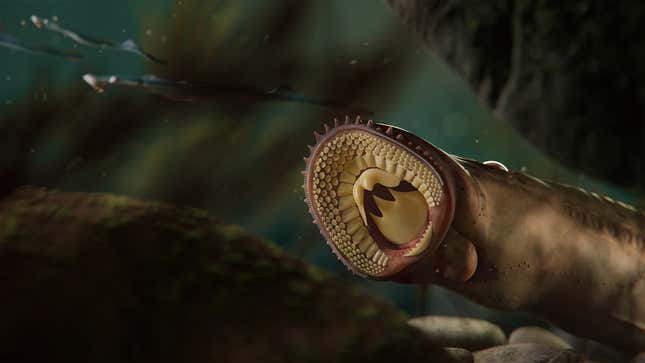Fossilized lampreys from the Jurassic period have surprised a team of paleontologists by their size and well-preserved feeding structures, indicating the creepy fish were already predatory 160 million years ago.
Scientists recently identified two new lamprey species, Yanliaomyzon occisor and Yanliaomyzon ingensdentes, which translate to “killer” and “large teeth,” respectively. Remarkably, these species are ten times longer than the earliest-known lampreys, indicating that this group of jawless vertebrates had already undergone significant evolution by the Jurassic period. The team’s research describing the new fossils and their implications was published today in Nature Communications.
Advertisement
Lampreys are lovely little creatures. The often-invasive, parasitic fish have a smooth, scaleless body that is supported by cartilage, giving them an appearance similar to eels. This unique structure allows some species to grow up to four feet long, according to the New York State Department of Environmental Conservation. But unlike eels, lampreys have no jaws. Instead, they have toothed oral suckers packed neatly inside their disk-shaped suction-cup mouths. Modern lampreys will plant their mouths on fish and use their tongues to remove the fish’s flesh, getting at the blood and fluids within. According to the National Ocean Service, one lamprey consumes about 40 pounds of fish each year.
Advertisement
“The ancestral feeding habit of living lampreys was probably flesh eating, rather than the conventionally held blood-sucking habit,” said Feixiang Wu, a paleontologist at the Chinese Academy of Sciences in Beijing and the study’s lead author, in an email to Gizmodo.
Advertisement
The two specimens were found in Yanliao Biota, near Nanshimen and Wubaiding, two villages in northern China. The bodies of the animals are well-preserved, with their oral discs and biting structures being in particularly good condition, providing critical clues to the researchers about their position in the ancestral tree of lampreys.
Y. occisor is just over two feet long (642 mm) and Y. ingensdentes is just under one foot long (296 mm), making them smaller than modern sea lampreys, pacific lampreys, pouched lampreys, and Arctic lampreys, all of which have maximum lengths of more than two feet.
Advertisement
The ancient lampreys have a similar physiology to the pouched lamprey (G. australis), leading the researchers to conclude that the origin of living lampreys is probably the Southern Hemisphere, not the Northern Hemisphere.

Advertisement
“Based on the large body size, the morphology of the feeding apparatus, and the freshwater living habitat, we assume that these Jurassic lampreys should be physiologically very close to living lampreys, especially to the flesh-eating pouch lamprey,” Wu said. “However, they have notable differences in the dorsal fins, as they have extraordinarily long dorsal fins, which should be very helpful in fueling the up-stream swimming for reproduction and long-distance oceanic dispersals to expand their geographical distribution.”
The team deduced that the two Chinese lampreys most likely experienced a three-stage life cycle. This conclusion was drawn from their phylogenetic placement (i.e. their position in the evolutionary tree), as they are situated between the ancient lamprey Mesomyzon and modern lampreys, both of which have been shown to have three life stages. Lampreys have a larval stage, which a different team of researchers suggested in 2021 may have been an adaptation that helped the animals move into freshwater environments.
Advertisement
The lamprey evolutionary story seems a niche one, but is an important one for fleshing out the story of all vertebrates.
More: A Bloodsucking Fish May Not Be the Vertebrate Ancestor We Thought
Services Marketplace – Listings, Bookings & Reviews